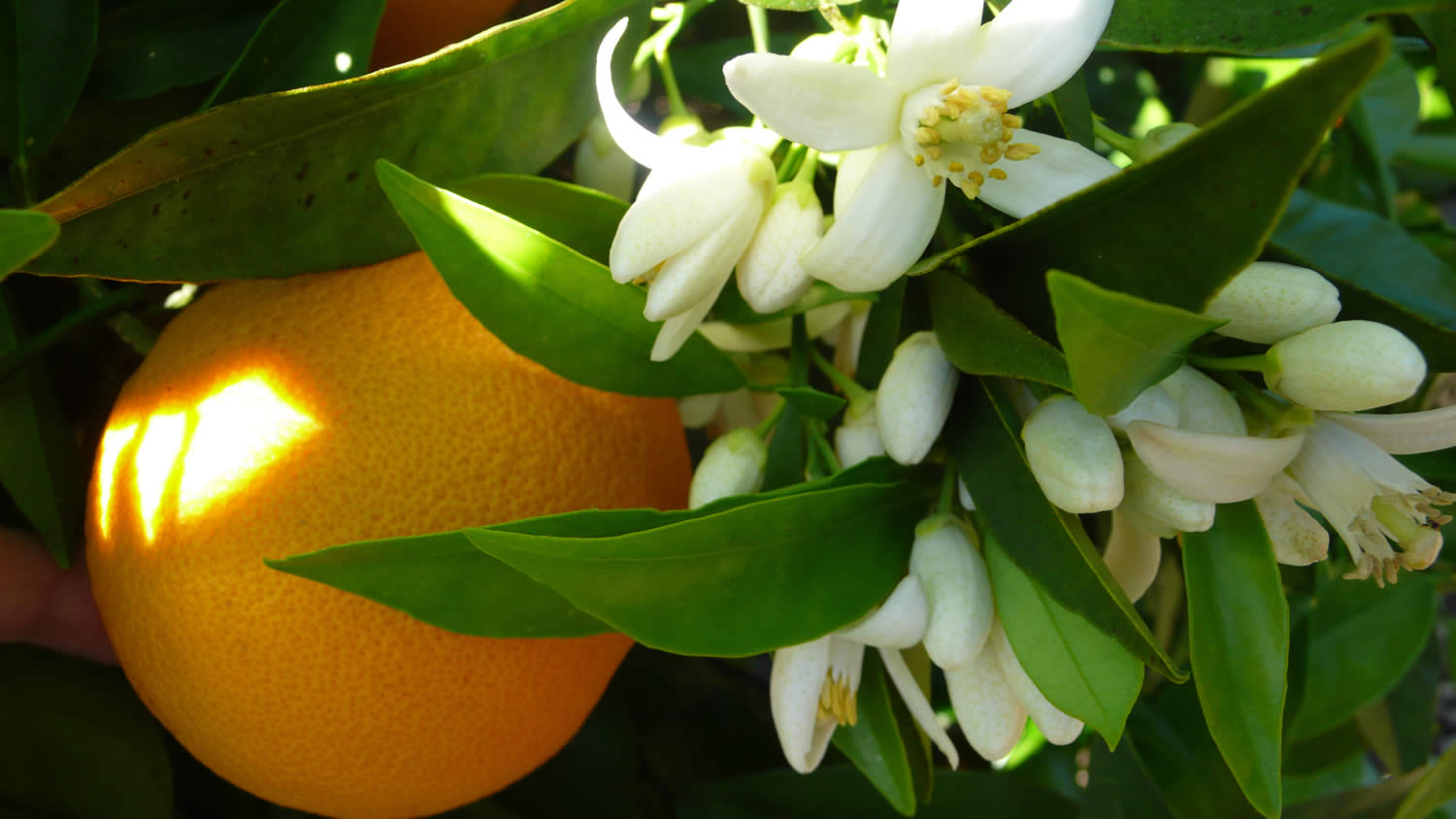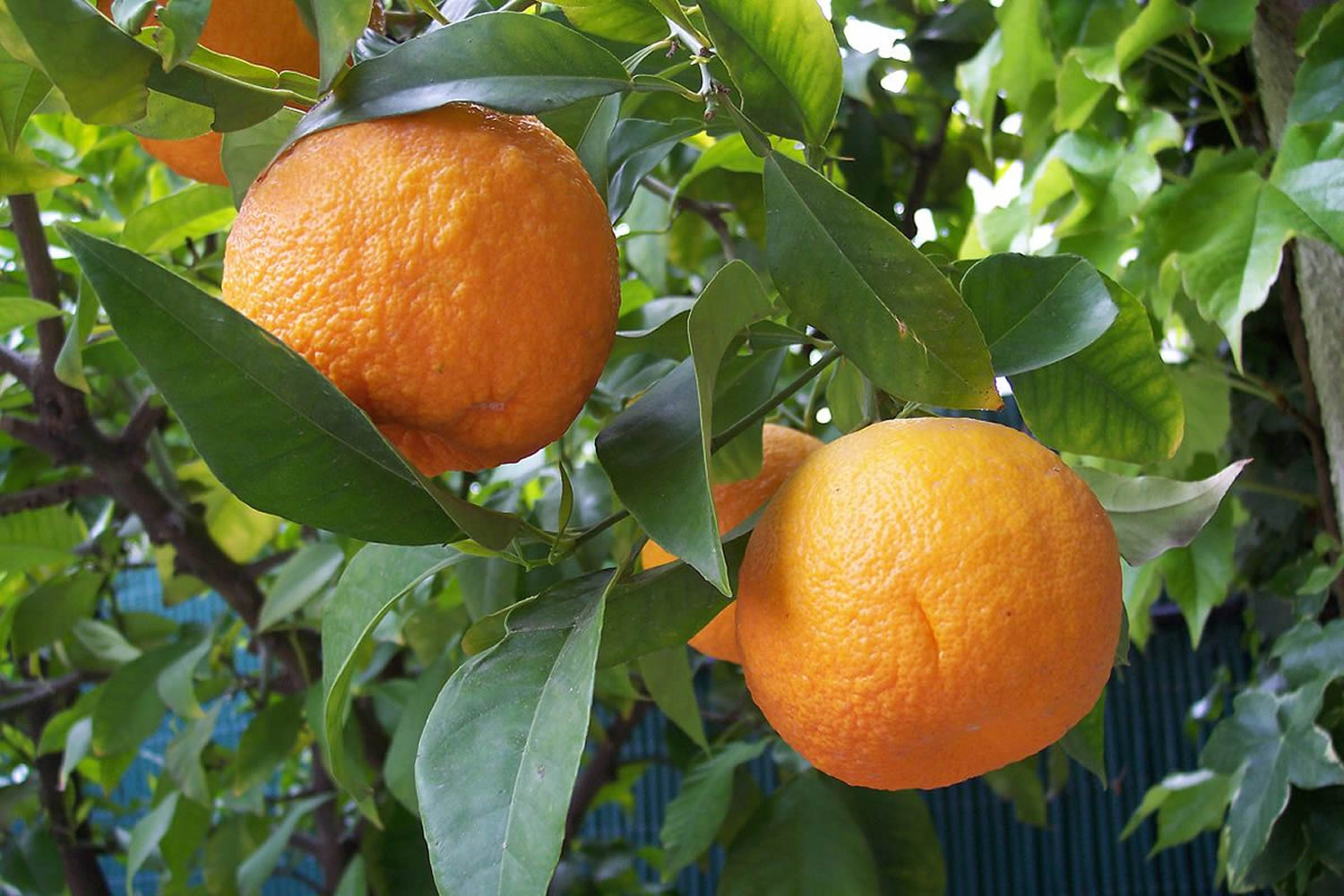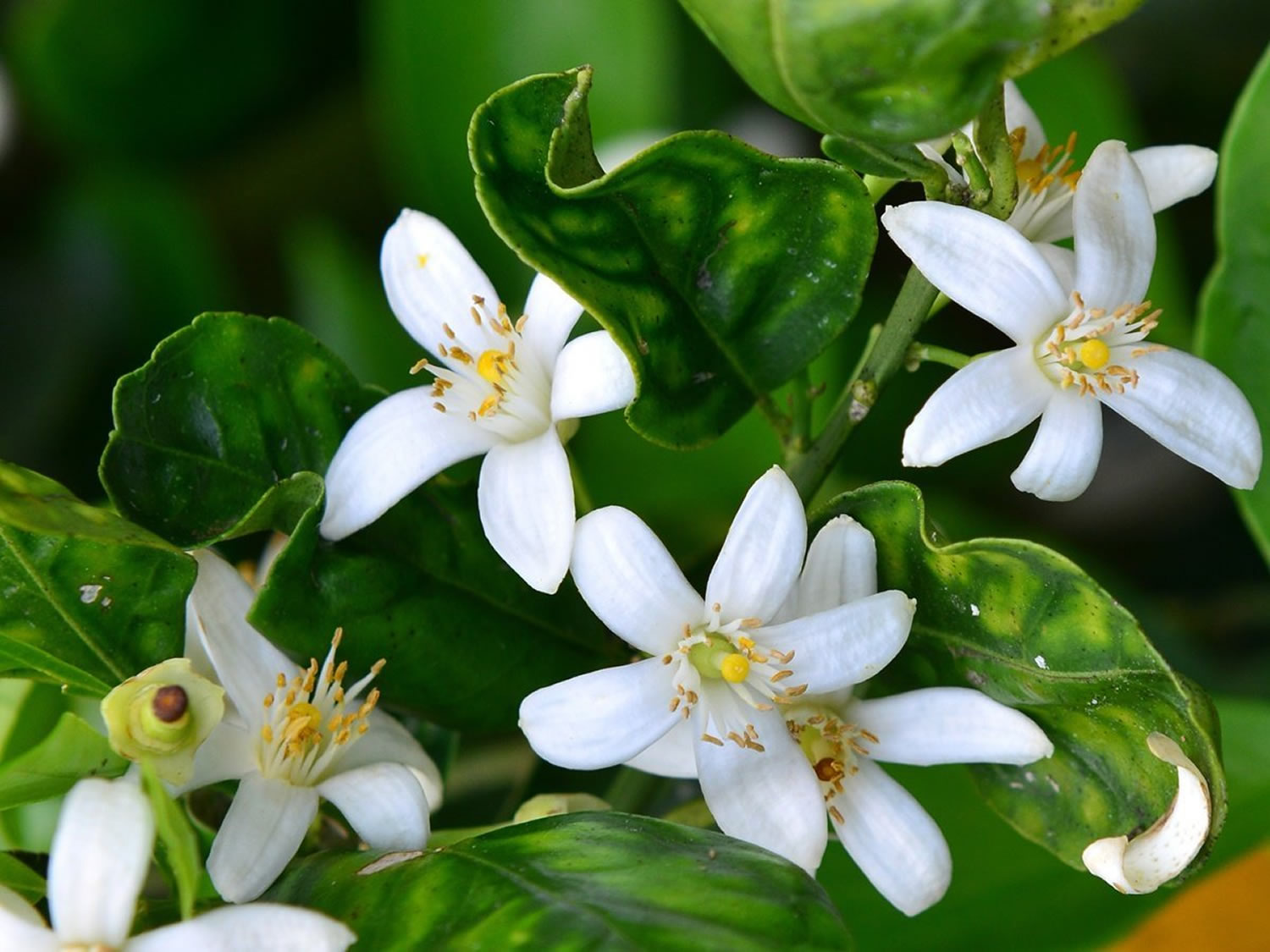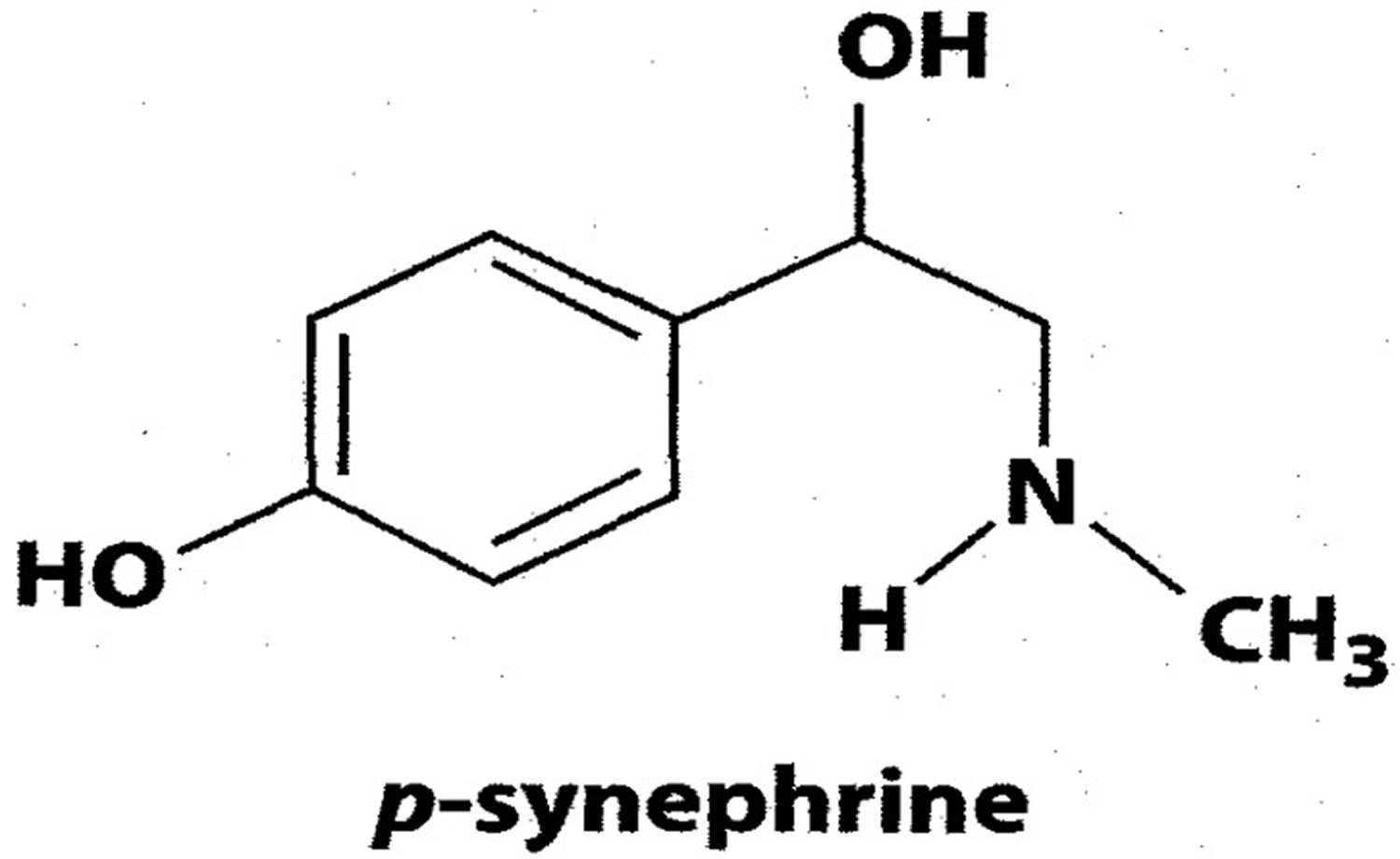What is neroli
Neroli (Citrus aurantium L. var. amara) is also called Bitter orange, Seville orange, Sour orange, Bigarade orange or Marmalade orange, refers to a citrus tree (Citrus × aurantium) and its fruit 1. Neroli (Citrus aurantium) which is native to eastern Africa and tropical Asia is now grown throughout the Mediterranean region and elsewhere, including California and Florida. The main constituents of Neroli orange peel are the volatile oil and an amorphous, bitter glucoside called aurantiamarin. Other constituents include hesperidin, a colorless, tasteless, crystalline glucoside occurring mainlyin the white zest of the peel, isohesperidin, hesperic acid, aurantiamaric acid, and a bitter acrid resin. In the peel of immature fruits, the chief constituents are naringin and hesperidin, while in the fruit flesh it is umbelliferone. p-Octopamine and p-synephrine, both adrenergic agonists, are the most frequently mentioned biogenic amines found in bitter orange peel and other Citrus aurantium preparations and other species such as Citrus reticulata Blanco (mandarin orange). Many varieties of Neroli are used for their essential oil and are found in perfume, used as a flavoring in foods and beverages or as a solvent. The Seville orange variety is used in the production of marmalade.
- Neroli has been used in traditional Chinese and Japanese herbal medicines and by indigenous people of the Amazon rainforest for constipation. Amazonian natives also used it for nausea and indigestion.
- Different preparations made from Neroli (Citrus aurantium L. var. amara) blossoms are commonly used in ethnobotanical practices for the treatment of pain and inflammation in Iran 2.
- Today, people use various Neroli products as a dietary supplement for heartburn, loss of appetite, nasal congestion, and weight loss. It is also applied to the skin for pain, bruises, and bed sores.
- Neroli, used in some weight-loss products, contains synephrine (see Figure 3) 3, which is similar to the main chemical in the herb ephedra. Ephedra is banned by the U.S. Food and Drug Administration because it raises blood pressure and is linked to heart attack and stroke 4.
- The National Collegiate Athletic Association (NCAA) placed synephrine (bitter orange) on its current list of banned drugs.
- The fruit, peel, flower, and oil are used and can be taken by mouth in tablets and capsules. Bitter orange oil can be applied to the skin.
Neroli (bitter oranges) are grown mainly for processing as preserves (especially, marmalade) and syrup due to their tart flavor. The essential oil is used to add fragrance to beverages and liqueurs (e.g., Curacao and Grand Marnier), sweet foods like candies and cakes, soaps, detergents, cosmetics, perfumes, and in sauces for meats and poultry. Neroli orange peel is used in many pharmacopoeial preparations as a flavoring agent, stomachic (assisting digestion) and carminative (relieving flatulence). Additionally, Neroli (bitter oranges) is reported to be an expectorant, laxative, hypertensive, nervine, tonic, and diuretic. The extract has been added to many dietary supplements and herbal weight loss formulas (as an alternative to ephedra). Synephrine is the “active” ingredient of bitter orange and functions as a stimulant. It is also used as a vasoconstrictor in circulatory failure. Octopamine is used as a cardiotonic and to treat hypotension.
Exposure to Neroli (bitter oranges) peel and its constituents occurs primarily via ingestion of the fruit itself or its products (e.g., orange juice, marmalade, flavorings and fragrances, and dietary supplements). Weight loss formulas usually contain 100-200 mg bitter orange extract, which provides 10-40 mg synephrine per dose. Extracts can contain up to 95% synephrine. Exposure can also result from peel oil used in aromatherapy and flavoring.
Figure 1. Neroli (bitter orange)
Figure 2. Neroli orange blossom
Neroli extract and human clinical studies
Neroli (Bitter orange) peel and its constituent synephrine are present in dietary supplements with and without ephedra (ma huang) for weight loss. Synephrine and other Neroli (Bitter orange) biogenic amine constituents—octopamine, N-methyltyramine, tyramine, and hordenine—have adrenergic activity and may result in cardiovascular or other adverse effects similar to those induced by ephedra alkaloids 5.
Neroli (bitter orange) is regulated by the U.S. Food and Drug Administration (FDA) 3; the peel, oil, extracts, and oleoresins are Generally Recognized as Safe as a direct additive to food 6. The peel is used in many pharmacopoeial preparations for flavoring and treatment of digestive problems. Oils from the fruit, peel, and other plant parts are also used for flavoring and fragrance and do not contain alkaloids. p-Octopamine and p-synephrine, the most frequently mentioned biogenic amines found in bitter orange extract, are agonists for both a- and b-adrenoceptors (octopamine has weak b-adrenergic activity) 5. Octopamine is used as a cardiotonic and to treat hypotension. Synephrine is used as a vasoconstrictor in circulatory failure. Extracts used in many dietary supplements and herbal weight-loss formulas as an alternative to ephedra have concentrations of the sympathomimetic alkaloid synephrine that are often much higher than the synephrine concentrations reported for traditional extracts of the dried fruit or peel.
Uncertainty has existed concerning the safety of Neroli (bitter orange) extract and p-synephrine. In general, there are the p-synephrine which is a phenylethylamine derivative that has the hydroxy group in the para position on the benzene ring and the synthetic m-synephrine (phenylephrine) which has a hydroxyl group in the meta position on the benzene ring) (Figures 3 and 4). m-Synephrine exhibits cardiovascular effects but is not a constituent of Neroli (bitter orange) 7, 8. Properties possessed by m-synephrine are inappropriately attributed to Neroli (bitter orange) extract and p-synephrine, and clinical case study reports and reviews involving bitter orange extract frequently make inappropriate references to m-synpephrine 9.
Concentrations of octopamine in extracts are less than those reported for synephrine. Weight loss formulas usually contain 100-200 mg bitter orange extract, which provides 10-40 mg synephrine per dose. Health concerns about bitter orange and other compounds in dietary supplements led to the FDA’s collection of product labels for the Center for Food Safety and Applied Nutrition to evaluate possible health risks. Concentrations of synephrine measured in several dietary products were generally lower than that declared on the label.
Following intraveous administration of synephrine to patients, ~66 and 10% of the administered dose was recovered in the urine as deaminated p-hydroxymandelic acid and unchanged synephrine, respectively (2.5% of the dose was recovered as unchanged synephrine following ingestion). Trace amounts of p- and m-octopamine and p- and m-synephrine were found in plasma and platelets of healthy human subjects. Low concentrations of octopamine, thought to be a metabolic byproduct of catecholamine biosynthesis, are present in the central nervous system and peripheral tissues of vertebrates. Oral exposure of mice to extracts of Neroli (bitter orange) peel suppressed cell viability of splenocytes and thymocytes. Oral exposure of rats to aqueous extracts of the immature fruit caused decreased food intake and body weight gain, ventricular arrhythmias, and inhibited Type I allergic reactions. Synephrine affected the sense organs and caused convulsions, dyspnea, cyanosis, and respiratory stimulation in other animal studies. Octopamine and synephrine were not mutagenic in Aspergillus nidulans diploid strains or L5178Y mouse lymphoma cells, respectively.
Pharmacologically, synephrine is similar to ephedrine but does not have its central nervous system (CNS) effects 5. Ephedrine is a plant derivative that agonizes α- and β-adrenergic receptors 10 in the heart and blood vessels, causing peripheral vasoconstriction and increased heart rate. This can have dramatic functional effects on the heart, because increased afterload and heart rate result not only in greater myocardial oxygen demand but in decreased diastolic filling and supply of oxygen to myocytes. Synephrine is therefore being considered as an alternate for ephedrine in dietary supplements 5. Synephrine and N-methyltyrosamine (chemicals found in immature C. aurantium fruit) have been shown to be effective antishock (i.e., primarily cardiotonic and vasoconstrictive) agents. In one study, 48 of 50 children with infective shock were cured when treated with synthetic synephrine and N-methyltyrosamine (1.66 to 24 mg/kg).
Case reports do exist of ischemic cerebrovascular accident, myocardial infarction, and unremitting tachycardia in association with synephrine use, but confounding factors exist in many of these reports 11, 12. The Canadian Health Department reports that, from 1 January 1998 through 28 February 2004, it received 16 reports of adverse cardiovascular events—including tachycardia, cardiac arrest, ventricular fibrillation, and syncope—in suspected association with the use of products containing bitter orange or synephrine 13. Products containing synephrine and that are promoted for weight loss are not authorized for sale in Canada.
Octopamine is used in Chinese medicine as a cardiotonic and to treat hypotension. The natural D(-) form is more potent that the L(+) form in producing cardiovascular adrenergic responses. In some invertebrates, it can also serve as a neurotransmitter.
Several human safety and efficacy studies have been conducted on bitter orange extract (p-synephrine) alone. However results involving both published and unpublished clinical studies indicate that p-synephrine alone or in combination with caffeine does not appear to produce significant adverse cardiovascular effects or pose a risk to human health at doses commonly ingested orally 9. No adverse effects have been directly attributable to bitter orange extract or p-synephrine 9. p-Synephrine/bitter orange extract alone as well as in combination with other ingredients results in significant increases in resting metabolic rate, and when taken for periods of time up to 12 weeks may result in modest weight loss 9.
The results indicate that bitter orange extract and p-synephrine increase metabolism and energy expenditure 9. The data accumulated to date do not support hypothesized concerns regarding potential adverse effects of p-synephrine particularly with respect to the cardiovascular system due to a paucity of binding to α-, β-1 and β-2 adrenergic receptors while exhibiting modest binding to β-3 adrenergic receptors 9. However, a need exists for additional well controlled, long term human efficacy and safety studies involving p-synephrine/bitter orange extract.
Figure 3. Chemical structure of p-Synephrine
[Source 9]Figure 4. Chemical structure of m-Synephrine
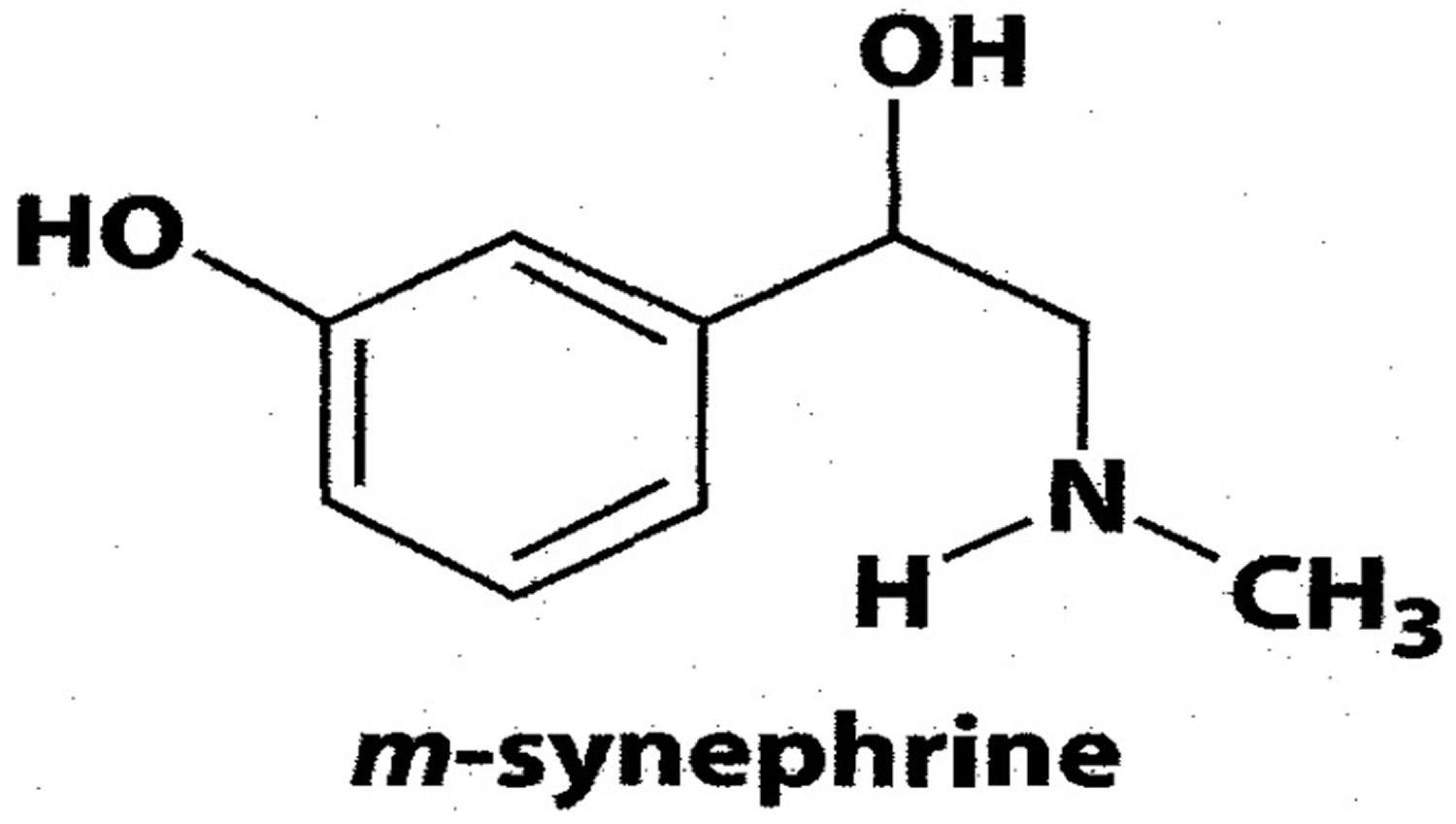 [Source 9]
[Source 9]
Neroli essential oil
Neroli oil is an essential oil produced from the blossom of Neroli or the Citrus aurantium blossom. The bitter orange blossom is the fragrant flower of Neroli (bitter orange tree). Its scent is sweet, honeyed and somewhat metallic with green and spicy facets. The bitter orange blossom oil and extracts are extensively used in perfumery. Neroli orange blossom can be described as smelling sweeter, warmer and more floral than neroli (the bitter orange fruit). The difference between how neroli and orange blossom smell and why they are referred to with different names, is a result of the process of extraction that is used to obtain the oil from the blooms. Neroli is extracted by steam distillation and orange blossom is extracted via a process of enfleurage.
Enfleurage is a process that uses odorless fats that are solid at room temperature to capture the fragrant compounds exuded by plants. The process can be “cold” enfleurage or “hot” enfleurage.
- In cold enfleurage, a large framed plate of glass, called a chassis, is smeared with a layer of animal fat, usually lard or tallow (from pork or beef, respectively), and allowed to set. Botanical matter, usually petals or whole flowers, is then placed on the fat and its scent is allowed to diffuse into the fat over the course of 1-3 days. The process is then repeated by replacing the spent botanicals with fresh ones until the fat has reached a desired degree of fragrance saturation. This procedure was developed in southern France in the 18th century for the production of high-grade concentrates.
- In hot enfleurage, solid fats are heated and botanical matter is stirred into the fat. Spent botanicals are repeatedly strained from the fat and replaced with fresh material until the fat is saturated with fragrance. This method is considered the oldest known procedure for preserving plant fragrance substances.
However, the enfleurage method of fragrance extraction is now superseded by more efficient techniques such as solvent extraction or supercritical fluid extraction using liquid carbon dioxide (CO2) or similar compressed gases.
Neroli essential oil benefits
Neroli was analyzed by gas chromatography–mass spectrometry and twenty three constituents, representing 91.0 % of neroli oil were identified. The major components of neroli were characterized as linalool (28.5%), linalyl acetate (19.6%), nerolidol (9.1%) E,E-farnesol (9.1%), α-terpineol (4.9%) and limonene (4.6%) 14 which might be responsible for the anticonvulsant activity. The analgesic activity of linalool has been previously examined in two different pain models, including the acetic acid-induced writhing response and the hot plate test in mice, and since the results have shown marked analgesic activity 2. Furthermore, other constituents in neroli, such as linalyl acetate, nerolidol, farnesol, α-terpineol, or limonene, might be the related active ones also. Limonene has been reported as a potent antinociceptive compound in some biological assays 15. α-Terpineol also represented an important tool for the management and/or treatment of painful conditions in several pharmacological assays and was characterized as responsible compounds for the analgesic activity of the oils 16. α-Terpineol also represented an important tool for the management and/or treatment of painful conditions in several pharmacological assays and was characterized as responsible compounds for the analgesic activity of the oils 16.
The essential oil of Citrus aurantium L. var. amara, also known as neroli oil, has been reported to have antianxiety effects by regulating 5-HT (serotonin) receptors in rats 17 and to have antidepressant effects through the monoaminergic system in mice 18. Neroli oil has also been reported to have sedative, antianxiety, and antidepressant effects on mice 19. In addition, limonene, one of the major chemical components in the essential oil of Neroli (Citrus aurantium L. var. amara), has been shown to have antianxiety 20 and motor relaxant effects, indicating sedative activity 21 in mice. Moreover, a study in rats reported that olfactory stimulation with grapefruit oil, which is rich in limonene, stimulated sympathetic nerves by activating histamine H1 receptors and that limonene treatment induced similar responses 22. Limonene-rich bergamot essential oil also demonstrated direct vasorelaxant effects 23.
Neroli essential oil also showed activity against acute and chronic inflammation. Carrageenan-induced edema has been commonly used as an experimental animal model for acute inflammation and is believed to be biphasic. The results for the paw edema showed significant reduction at doses of 40 and 80 mg/kg 2. The inhibitory activity shown by neroli during a period of 4 hour in carrageenan-induced paw inflammation was somehow similar to that exhibited by the group treated with diclofenac sodium (a nonsteroidal anti-inflammatory drug). These results indicate that neroli acts in later phases, probably involving arachidonic acid metabolites, which produce an edema dependent on neutrophils mobilization 24. The granulomatous tissue induction is a widely used method for the assessment of chronic anti-inflammatory substances 25. Neroli essential oil effectively and significantly reduced cotton pellet-induced granuloma, thereby suggesting its activity in the proliferative phase of the inflammation. The anti-inflammatory activity of neroli could be related to the inhibition of nitric oxide (NO) formation/release. Many reports have suggested that nitric oxide (NO), peripherally produced by different nitric oxide synthase (NOS) isoforms, contributes to edema formation 26. Regardless of the detailed mechanism, it is true that neroli produces an anti-inflammatory effect through the inhibition of NO production. Pharmacological evaluation of linalool in mice also revealed that linalool and the corresponding acetate play a major role in the anti-inflammatory activity displayed by the essential oils containing them, and provide further evidence suggesting that linalool and linalyl acetate-producing species are potentially anti-inflammatory agents 27.
Neroli (Citrus aurantium L.) is used as an alternative treatment in some countries, including Iran, to relieve insomnia, anxiety, inflammation, depression, epilepsy, and seizures 28. Neroli essential oil has shown significant anticonvulsant activity and increases the latency period of tonic seizures in the pentylenetetrazol and maximal electroshock models 29. It was found that the Neroli blossoms extract also has a significant reduction effect on the latency of the onset of seizure and the duration of seizure with higher dose (300 mg/kg) 30 related to neroli (20 mg/kg) 29. Neroli (Citrus aurantium L.) blossom extract has also shown effectiveness in terms of reduction in preoperative anxiety before minor operations 31.
Neroli essential oil side effects
Neroli (bitter orange) is also employed in herbal medicine as a stimulant and appetite suppressant, due to its active ingredient, synephrine 32. Neroli (bitter orange) supplements have been linked to a number of serious side effects like fainting, heart-rhythm disorders, heart attack, stroke and even death 33. According to the National Center for Complementary and Integrative Health, there are case reports of healthy people experiencing fainting, heart attack, and stroke after taking bitter orange alone or with caffeine 34. Case reports have linked bitter orange supplements to strokes 35, 36, angina 37 and ischemic colitis 38. Following an incident in which a healthy young man suffered a myocardial infarction (heart attack) linked to bitter orange, a case study found that dietary supplement manufacturers had replaced ephedra with its analogs from bitter orange 39. However, evidence regarding the effects of bitter orange (alone or combined with other substances, such as caffeine and green tea) on the heart and cardiovascular system are inconclusive 34. Because products that contain bitter orange may be unsafe, pregnant women and nursing mothers should avoid them.
In volunteers receiving skin applications of bitter orange peel oil expressed (5 μL/cm2 of 100% oil) under occlusion followed by exposure to visible light or ultraviolet A, all subjects exhibited phototoxic reactions.
Chronic exposure, cytotoxicity, carcinogenicity, or tumor initiation/promotion studies were not available 5.
References- Orange peel, bitter. In: Blumenthal M, Goldberg A, Brinckmann J, eds. Herbal Medicine: Expanded Commission E Monographs. Newton, MA: Integrative Medicine Communications; 2000:287-289.
- Analgesic and anti-inflammatory activities of Citrus aurantium L. blossoms essential oil (neroli): involvement of the nitric oxide/cyclic-guanosine monophosphate pathway. Khodabakhsh, P., Shafaroodi, H. & Asgarpanah, J. J Nat Med (2015) 69: 324. https://doi.org/10.1007/s11418-015-0896-6
- https://www.fda.gov/iceci/enforcementactions/warningletters/2015/ucm464091.htm
- https://www.fda.gov/safety/medwatch/safetyinformation/safetyalertsforhumanmedicalproducts/ucm560485.htm
- https://ntp.niehs.nih.gov/ntp/htdocs/chem_background/exsumpdf/bitterorange_508.pdf
- https://www.fda.gov/downloads/food/ingredientspackaginglabeling/gras/noticeinventory/ucm362939.pdf
- Pellati F, Benvenuti S. Chromatographic and electrophoretic methods for the analysis of phenethylamine alkaloids in Citrus aurantium. J Chromatog A. 2007;1171:71–88. https://www.ncbi.nlm.nih.gov/pubmed/17582424
- Evans RL, Pho AN, Roman MC, Betz JM. Certification of standard reference materials containing bitter orange. Analyt Bioanalyt Chem. 2008;391:2023–2034. https://www.ncbi.nlm.nih.gov/pubmed/18425642
- Stohs SJ, Preuss HG, Shara M. A Review of the Human Clinical Studies Involving Citrus aurantium (Bitter Orange) Extract and its Primary Protoalkaloid p-Synephrine. International Journal of Medical Sciences. 2012;9(7):527-538. doi:10.7150/ijms.4446. https://www.ncbi.nlm.nih.gov/pmc/articles/PMC3444973/
- Shekelle P, Hardy ML, Morton SC, Maglione M, Suttorp M, Roth E, et al. Ephedra and ephedrine for weight loss and athletic performance enhancement: clinical efficacy and side effects. Evid Rep Technol Assess (Summ) 2003;(76):1–4. https://www.ncbi.nlm.nih.gov/books/NBK36915/
- Haller CA, Benowitz NL. Adverse cardiovascular and central nervous system events associated with dietary supplements containing ephedra alkaloids. N Engl J Med 2000;343(25): 1833–8. http://www.nejm.org/doi/full/10.1056/NEJM200012213432502
- Nykamp DL, Fackih MN, Compton AL. Possible association of acute lateral-wall myocardial infarction and bitter orange supplement. Ann Pharmacother 2004;38(5):812–6. https://www.ncbi.nlm.nih.gov/pubmed/15026566
- Jordan S, Murty M, Pilon K. Products containing bitter orange or synephrine: suspected cardiovascular adverse reactions. Canadian Adverse Reaction Newsletter 2004;14(4):3–4.
- Anticonvulsant activity of Citrus aurantium blossom essential oil (neroli): involvment of the GABAergic system. Nat Prod Commun. 2014 Nov;9(11):1615-8. https://www.ncbi.nlm.nih.gov/pubmed/25532295
- do Amaral JF, Silva MI, Neto MR, Neto PF, Moura BA, de Melo CT, de Araújo FL, de Sousa DP, de Vasconcelos PF, de Vasconcelos SM, de Sousa FC (2007) Antinociceptive effect of the monoterpene R-(+)-limonene in mice. Biol Pharm Bull 30(7):1217–1220 https://www.jstage.jst.go.jp/article/bpb/30/7/30_7_1217/_pdf/-char/en
- Quintans-Júnior LJ, Oliveira MG, Santana MF, Santana MT, Guimarães AG, Siqueira JS, De Sousa DP, Almeida RN (2011) α-Terpineol reduces nociceptive behavior in mice. Pharm Biol 49(6):583–586 https://www.ncbi.nlm.nih.gov/pubmed/21385090
- Citrus aurantium L. essential oil exhibits anxiolytic-like activity mediated by 5-HT(1A)-receptors and reduces cholesterol after repeated oral treatment. Costa CA, Cury TC, Cassettari BO, Takahira RK, Flório JC, Costa M. BMC Complement Altern Med. 2013 Feb 23; 13():42. https://www.ncbi.nlm.nih.gov/pmc/articles/PMC3598547/
- Involvement of monoaminergic systems in the antidepressant-like effect of nobiletin. Yi LT, Xu HL, Feng J, Zhan X, Zhou LP, Cui CC. Physiol Behav. 2011 Jan 10; 102(1):1-6. https://www.ncbi.nlm.nih.gov/pubmed/20951716/
- Sedative, anxiolytic and antidepressant activities of Citrus limon (Burn) essential oil in mice. L M Lopes C, Gonçalves e Sá C, de Almeida AA, da Costa JP, Marques TH, Feitosa CM, Saldanha GB, de Freitas RM. Pharmazie. 2011 Aug; 66(8):623-7. https://www.ncbi.nlm.nih.gov/pubmed/21901988/
- Evaluation of acute toxicity of a natural compound (+)-limonene epoxide and its anxiolytic-like action. de Almeida AA, Costa JP, de Carvalho RB, de Sousa DP, de Freitas RM. Brain Res. 2012 Apr 11; 1448():56-62. https://www.ncbi.nlm.nih.gov/pubmed/22364736/
- Central effects of citral, myrcene and limonene, constituents of essential oil chemotypes from Lippia alba (Mill.) n.e. Brown. do Vale TG, Furtado EC, Santos JG Jr, Viana GS. Phytomedicine. 2002 Dec; 9(8):709-14. https://www.ncbi.nlm.nih.gov/pubmed/12587690/
- Olfactory stimulation with scent of grapefruit oil affects autonomic nerves, lipolysis and appetite in rats. Shen J, Niijima A, Tanida M, Horii Y, Maeda K, Nagai K. Neurosci Lett. 2005 Jun 3; 380(3):289-94. https://www.ncbi.nlm.nih.gov/pubmed/15862904/
- The essential oil of Citrus bergamia Risso induces vasorelaxation of the mouse aorta by activating K(+) channels and inhibiting Ca(2+) influx. Kang P, Suh SH, Min SS, Seol GH. J Pharm Pharmacol. 2013 May; 65(5):745-9. https://www.ncbi.nlm.nih.gov/pubmed/23600392/
- Just MJ, Recio MC, Giner RM, Cuéllar MJ, Máñez S, Bilia AR, Ríos JL (1998) Anti-inflammatory activity of unusual lupane saponins from Bupleurum fruticescens. Planta Med 64:404–407 https://www.ncbi.nlm.nih.gov/pubmed/9690340
- Swingle KF, Shideman FE (1972) Phases of the inflammatory response to subcutaneous implantation of a cotton pellet and their modification by certain anti-inflammatory agents. J Pharmacol Exp Ther 183:226–234
- Rivot JP, Montagne-Clavel J, Besson JM (2002) Subcutaneous formalin and intraplantar carrageenan increase nitric oxide release as measured by in vivo voltammetry in the spinal cord. Eur J Pain 6(1):25–34 https://www.ncbi.nlm.nih.gov/pubmed/11888225
- Peana AT, D’Aquila PS, Panin F, Serra G, Pippia P, Moretti MD (2002) Anti-inflammatory activity of linalool and linalyl acetate constituents of essential oils. Phytomedicine 9(8):721–726 https://www.ncbi.nlm.nih.gov/pubmed/12587692
- Carvalho-Freitas MIR, Costa M (2002) Anxiolytic and sedative effects of extracts and essential oil from Citrus aurantium L. Biol Pharm Bull 25:1629–1633. https://www.jstage.jst.go.jp/article/bpb/25/12/25_12_1629/_pdf/-char/en
- Azanchi T, Shafaroodi H, Asgarpanah J (2014) Anticonvulsant activity of Citrus aurantium blossom essential oil (neroli): involvment of the GABAergic system. Nat Prod Commun 9(11):1615–1618 https://www.ncbi.nlm.nih.gov/pubmed/25532295
- Abbasnejad M, Keramat B, Esmaili Mahani S, Rezaeezade Roukerd M (2012) Effect of hydro-methanolic extract of sour orange flowers, Citrus aurantium, on pentylentetrazole induced seizure in male rats. J Babol Univ Med Sci 14:18–22
- Akhlaghi M, Shabanian G, Rafieian-Kopaei M, Parvin N, Saadat M, Akhlaghi M (2011) Citrus aurantium blossom and preoperative anxiety. Braz J Anesthesiol 61:707–712
- Availability of weight-loss supplements: Results of an audit of retail outlets in a southeastern city. J Am Diet Assoc. 2006 Dec;106(12):2045-51. http://jandonline.org/article/S0002-8223(06)02096-7/fulltext
- The dangers of dietary and nutritional supplements investigated. What you don’t know about these 12 ingredients could hurt you. https://www.consumerreports.org/cro/2012/05/dangerous-supplements/index.htm
- Bitter Orange. https://nccih.nih.gov/health/bitterorange
- Ischemic stroke associated with use of an ephedra-free dietary supplement containing synephrine. Mayo Clin Proc. 2005 Apr;80(4):541-5. https://www.ncbi.nlm.nih.gov/pubmed/15819293
- Vasospasm and stroke attributable to ephedra-free xenadrine: case report. Mil Med. 2008 Jul;173(7):708-10. https://www.ncbi.nlm.nih.gov/pubmed/18700609
- Variant angina associated with bitter orange in a dietary supplement. Mayo Clin Proc. 2006 Apr;81(4):545-8. https://www.ncbi.nlm.nih.gov/pubmed/16610576
- Ischemic colitis associated with use of a bitter orange-containing dietary weight-loss supplement. Mayo Clin Proc. 2006 Dec;81(12):1630-1. https://www.ncbi.nlm.nih.gov/pubmed/17165643
- Thomas JE, Munir JA, McIntyre PZ, Ferguson MA. STEMI in a 24-Year-Old Man after Use of a Synephrine-Containing Dietary Supplement: A Case Report and Review of the Literature. Texas Heart Institute Journal. 2009;36(6):586-590. https://www.ncbi.nlm.nih.gov/pmc/articles/PMC2801940/
